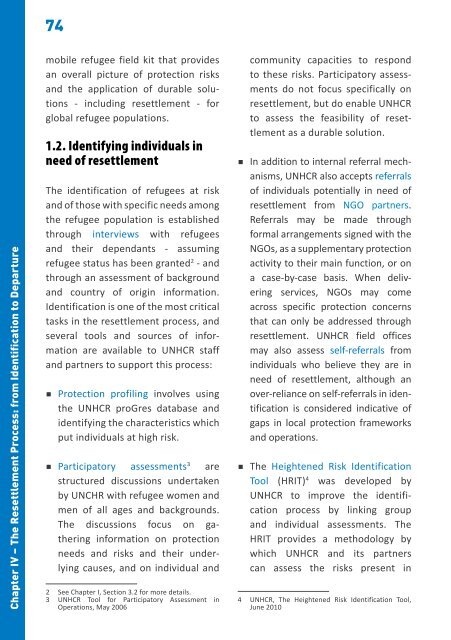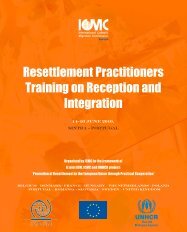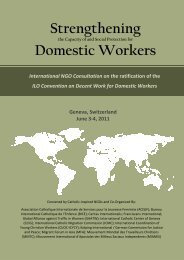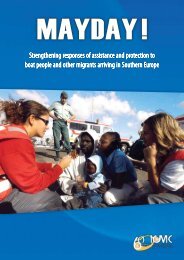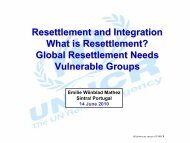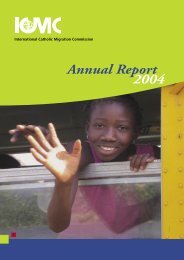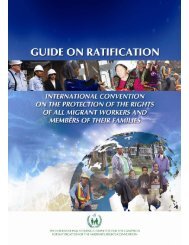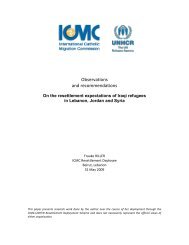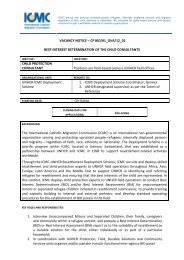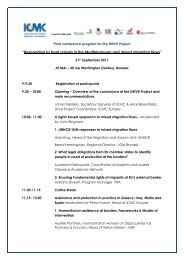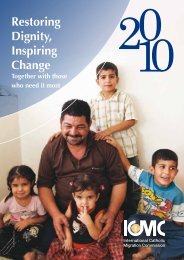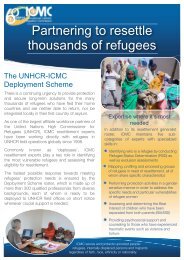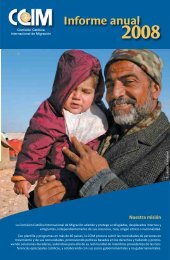ICMCEUROPE WelcometoEurope.pdf (5.89 MB)
ICMCEUROPE WelcometoEurope.pdf (5.89 MB)
ICMCEUROPE WelcometoEurope.pdf (5.89 MB)
Create successful ePaper yourself
Turn your PDF publications into a flip-book with our unique Google optimized e-Paper software.
74<br />
Chapter IV – The Resettlement Process: from Identification to Departure<br />
mobile refugee field kit that provides<br />
an overall picture of protection risks<br />
and the application of durable solutions<br />
- including resettlement - for<br />
global refugee populations.<br />
1.2. Identifying individuals in<br />
need of resettlement<br />
The identification of refugees at risk<br />
and of those with specific needs among<br />
the refugee population is established<br />
through interviews with refugees<br />
and their dependants - assuming<br />
refugee status has been granted 2 - and<br />
through an assessment of background<br />
and country of origin information.<br />
Identification is one of the most critical<br />
tasks in the resettlement process, and<br />
several tools and sources of information<br />
are available to UNHCR staff<br />
and partners to support this process:<br />
• Protection profiling involves using<br />
the UNHCR proGres database and<br />
identifying the characteristics which<br />
put individuals at high risk.<br />
• Participatory assessments 3 are<br />
structured discussions undertaken<br />
by UNCHR with refugee women and<br />
men of all ages and backgrounds.<br />
The discussions focus on gathering<br />
information on protection<br />
needs and risks and their underlying<br />
causes, and on individual and<br />
2 See Chapter I, Section 3.2 for more details.<br />
3 UNHCR Tool for Participatory Assessment in<br />
Operations, May 2006<br />
community capacities to respond<br />
to these risks. Participatory assessments<br />
do not focus specifically on<br />
resettlement, but do enable UNHCR<br />
to assess the feasibility of resettlement<br />
as a durable solution.<br />
• In addition to internal referral mechanisms,<br />
UNHCR also accepts referrals<br />
of individuals potentially in need of<br />
resettlement from NGO partners.<br />
Referrals may be made through<br />
formal arrangements signed with the<br />
NGOs, as a supplementary protection<br />
activity to their main function, or on<br />
a case-by-case basis. When delivering<br />
services, NGOs may come<br />
across specific protection concerns<br />
that can only be addressed through<br />
resettlement. UNHCR field offices<br />
may also assess self-referrals from<br />
individuals who believe they are in<br />
need of resettlement, although an<br />
over-reliance on self-referrals in identification<br />
is considered indicative of<br />
gaps in local protection frameworks<br />
and operations.<br />
• The Heightened Risk Identification<br />
Tool (HRIT) 4 was developed by<br />
UNHCR to improve the identification<br />
process by linking group<br />
and individual assessments. The<br />
HRIT provides a methodology by<br />
which UNHCR and its partners<br />
can assess the risks present in<br />
4 UNHCR, The Heightened Risk Identification Tool,<br />
June 2010


